Snacking often gets a bad rap in the weight loss world, but when done right, it can be an integral part of a successful weight management plan.
High-protein snacks are particularly valuable because they help maintain muscle mass, keep you feeling full, and stabilize blood sugar levels, reducing the likelihood of overeating at later meals.
Protein’s role in promoting satiety and supporting metabolism makes these snacks an excellent choice for those looking to shed pounds without feeling deprived.
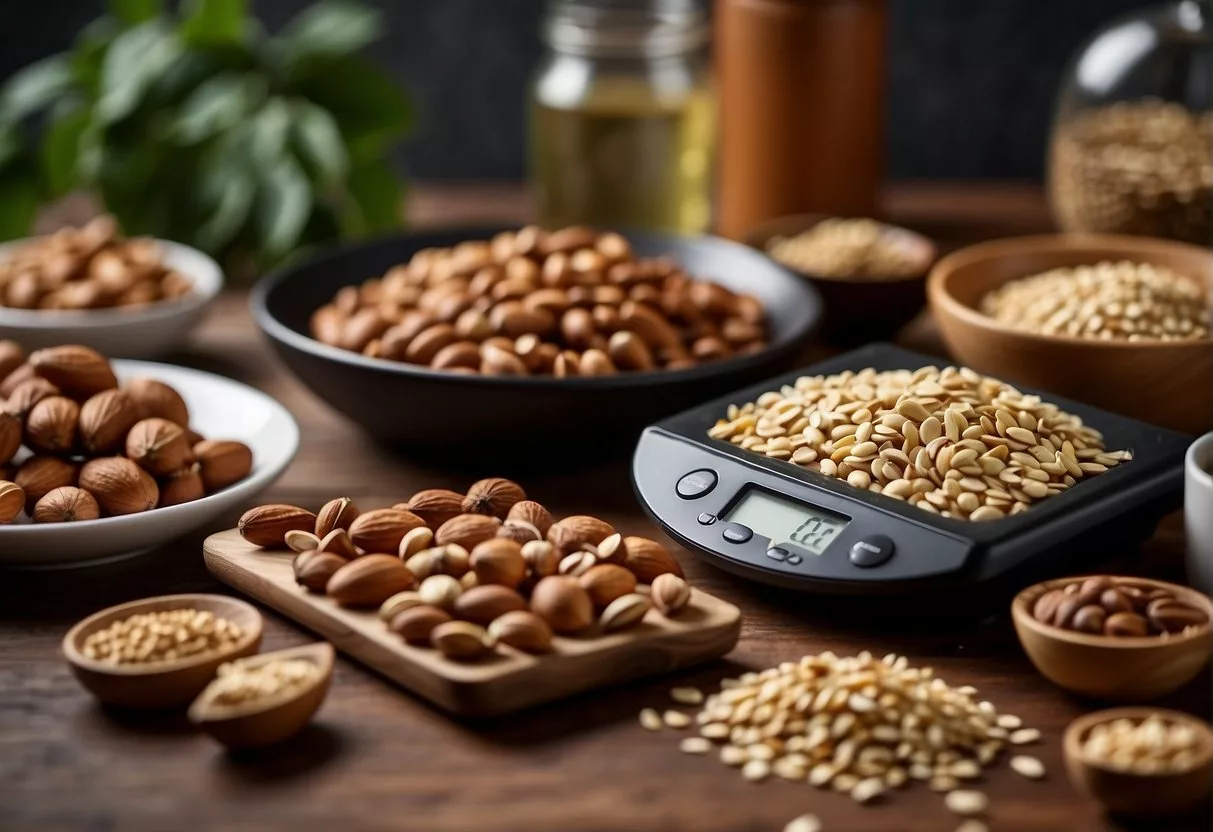
Selecting the right high-protein snacks is crucial for those aspiring to lose weight quickly and healthily.
It’s important to look for snacks that not only offer a protein boost but are also low in calories and rich in other nutrients.
Careful preparation and smart shopping can lead to satisfying snack options that align with dietary restrictions and contribute to a balanced diet.
When high-protein snacks are integrated thoughtfully, they can aid in long-term weight maintenance and overall well-being.
Key Takeaways
- High-protein snacks can help maintain muscle mass and increase satiety.
- Choosing nutrient-rich, low-calorie snacks is key for quick weight loss.
- Thoughtful integration of snacks is essential for sustainable weight loss.
Understanding Protein and Weight Loss
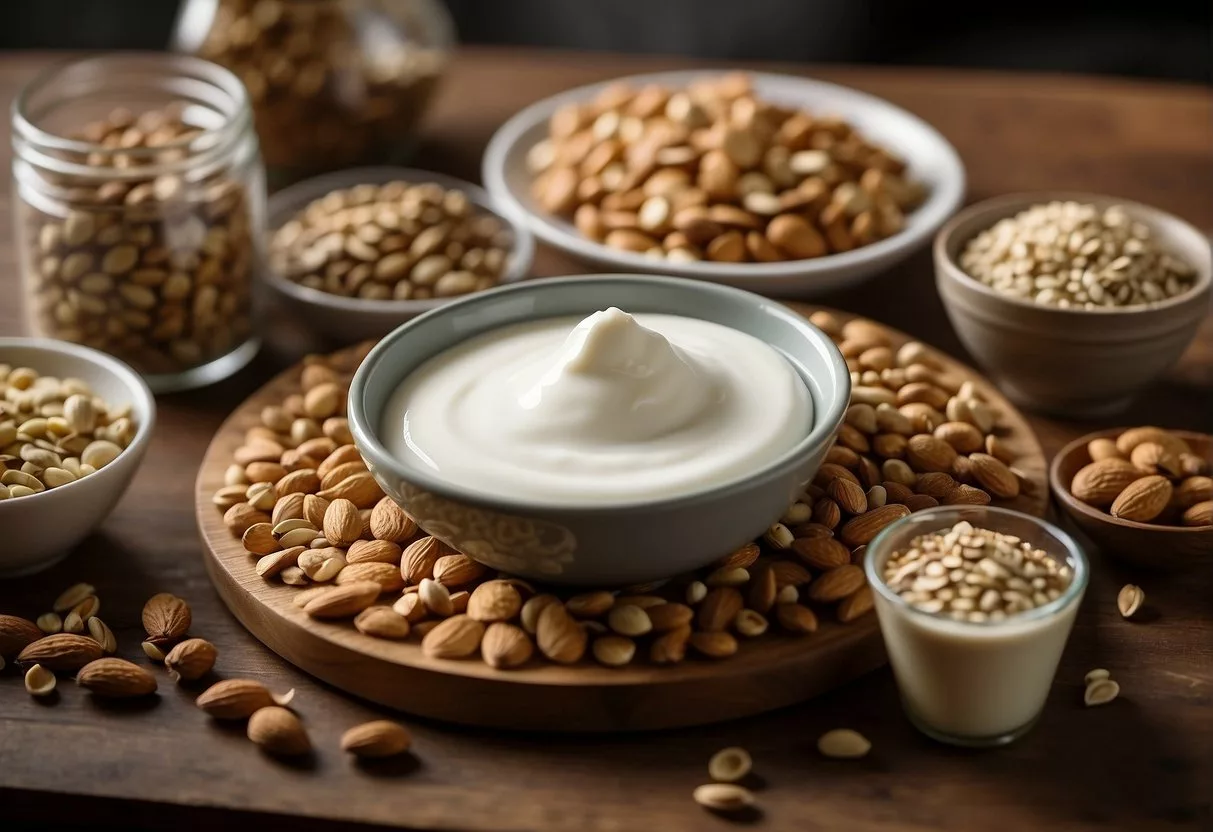
Protein is a critical macronutrient in any healthy diet. It is essential for the building and repair of tissues in the body, and it plays a key role in weight loss and management.
Consuming high-protein foods can increase feelings of fullness, reducing the overall intake of calories and making it easier to adhere to a weight loss regimen.
Protein’s Role in Digestion
- Protein-rich foods require more energy to metabolize, providing a thermogenic effect.
- This process boosts metabolism, aiding in weight loss.
Nutrient Density and Satiety
- Nutrient-dense foods provide a high amount of nutrients relative to their calorie content.
- Meanwhile, protein helps maintain muscle mass during weight loss, contributing to a leaner physique.
Protein Sources
- Animal sources: Chicken, turkey, lean beef, fish, eggs, and dairy products.
- Plant sources: Legumes, nuts, seeds, and soy products like edamame.
Incorporating a variety of protein sources ensures a broad range of essential amino acids.
A healthy diet that includes sufficient protein can support healthy digestion, encourage muscle growth, and assist in maintaining bone health.
For those seeking weight loss, integrating high-protein snacks and meals into their diet is a strategy that can offer sustainable results without compromising nutritional needs.
It’s not just the quantity but the quality of protein that supports an effective weight loss journey.
Best High-Protein Snacks for Quick Weight Loss
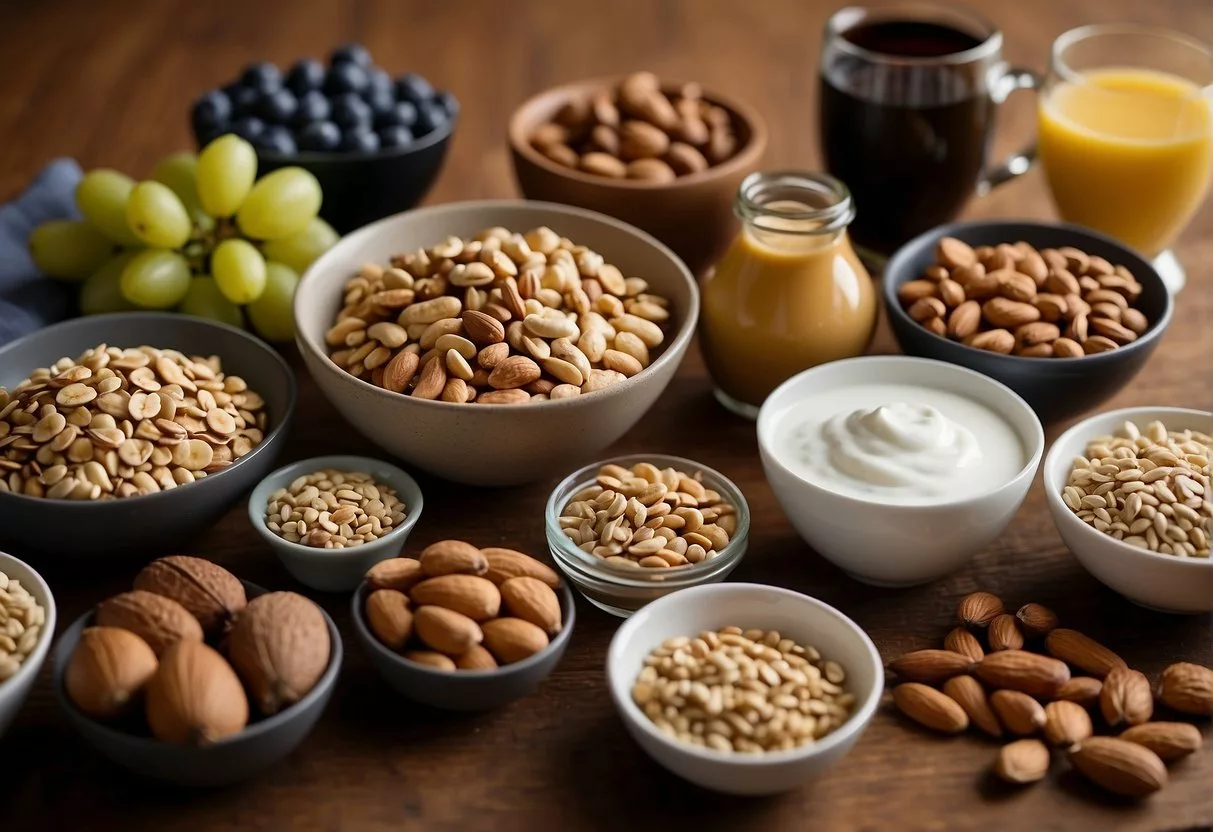
When striving for quick weight loss, incorporating high-protein snacks can help maintain muscle mass and reduce cravings. Protein-rich foods increase satiety, which can lead to fewer calories consumed overall.
Nuts and Seeds: A handful of almonds or a mix of seeds offer healthy fats and fiber alongside protein. These are great for on-the-go snacking. Just be mindful of portions due to their high calorie density.
Dairy and Dairy Alternatives: Greek yogurt and cottage cheese are excellent sources of protein and can be paired with fruit or honey for a satisfying snack. Low-fat cheese sticks or slices are also convenient and portable.
| Snack | Protein Content | Note |
|---|---|---|
| Hard-boiled egg | ~6g per egg | Easy to prepare in advance. |
| Turkey slices | Varies | Look for low-sodium options. |
| Tuna | ~25g per can | Mix with a little mayo or Greek yogurt. |
Plant-Based Options: Edamame and roasted chickpeas are not only high in protein but also provide essential nutrients and fiber. They satisfy the craving for a crunchy snack.
For those craving a slightly sweeter option, a protein smoothie made with protein powder and a variety of fruits or nut butter can be both filling and muscle-sparing.
Lastly, jerky and beef jerky are great for satisfying savory cravings. However, it’s essential to select options that are low in sodium and sugar for the healthiest choice.
It’s important for individuals to listen to their body’s hunger cues and choose snacks that not just facilitate weight loss but also support overall health.
Snacks like tuna, turkey, or hard-boiled eggs can replace more calorie-dense options while providing the body with essential nutrients.
Nutritional Benefits of High-Protein Snacks
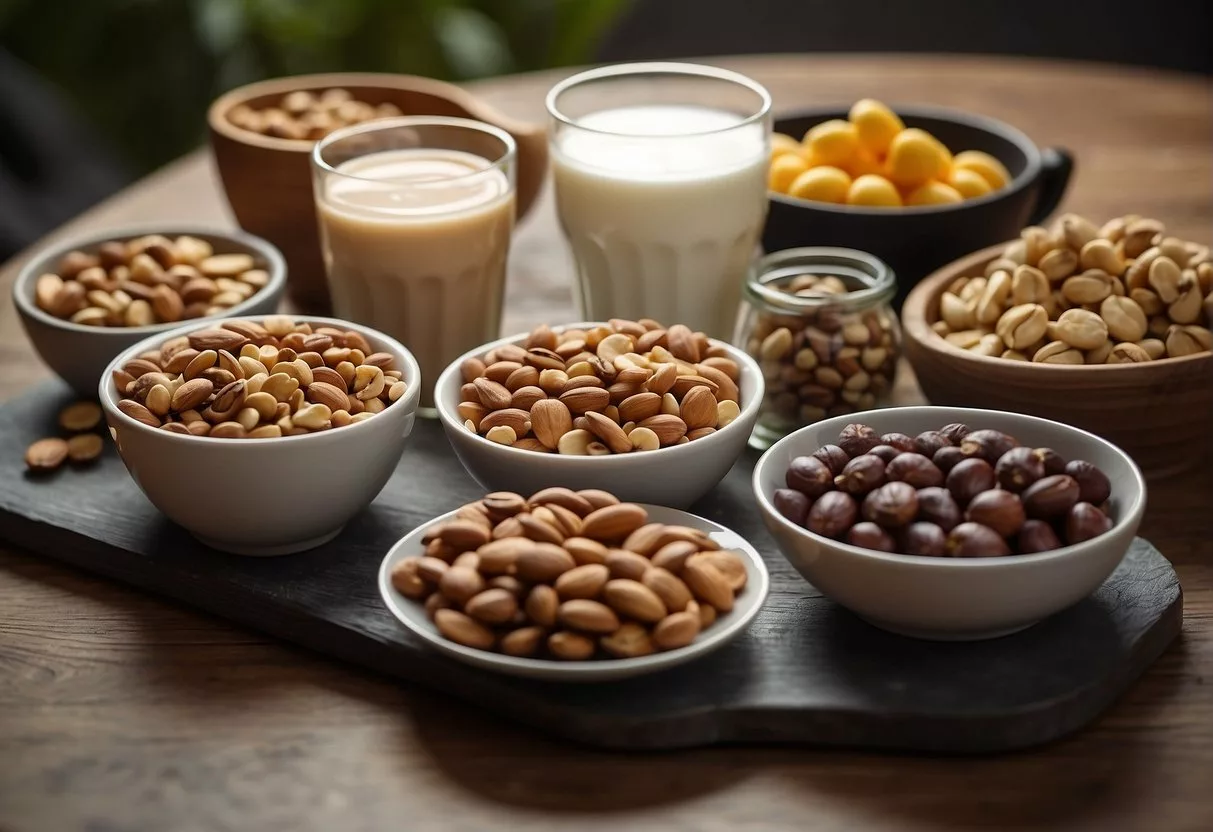
High-protein snacks are critical in supporting quick weight loss because they can help maintain muscle mass while promoting fat loss.
Proteins take longer to digest than carbohydrates, which can lead to increased satiety and a reduction in overall calorie intake.
Fiber is another beneficial nutrient often found in high-protein snacks, especially when they include vegetables or legumes.
For instance, roasted chickpeas not only provide a protein boost but also supply fiber, which aids in digestion and can contribute to feelings of fullness.
Many high-protein snacks come fortified with essential minerals such as iron, zinc, and selenium that support immune function and overall health.
Calcium and phosphorus, found in dairy-based snacks like Greek yogurt, are vital for bone health.
Including fruits and berries such as apple slices and blueberries in these snacks adds beneficial vitamins and antioxidants without significantly increasing calorie count.
Berries are particularly high in folate and vitamin C, while apples are a good source of dietary fiber.
- Healthy fats, including omega-3 fatty acids, are present in snacks like smoked salmon on toast, contributing to cardiovascular health.
- Nuts and seeds, often used in high-protein snacks, provide magnesium, manganese, and potassium.
When chosen carefully, high-protein snacks with these nutrients support weight loss by enhancing metabolic health, maintaining lean muscle tissue, and keeping hunger pangs at bay.
Special Considerations for Dietary Restrictions
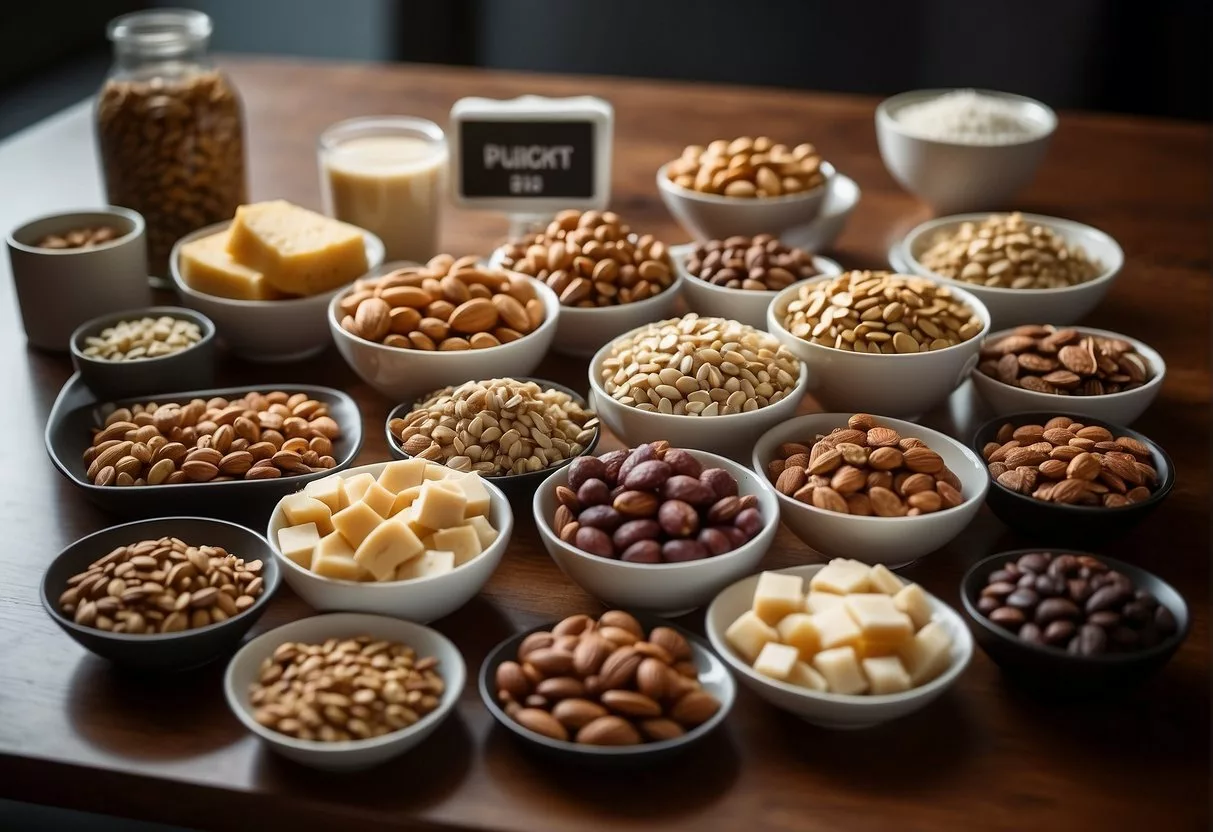
When selecting high-protein snacks for weight loss, one must pay close attention to dietary restrictions to ensure that the snack is both effective and appropriate for their diet.
Here are some key considerations for various restrictions:
For a vegan diet, where all animal products are excluded, one can opt for high-protein snacks that rely on plant-based protein.
Examples include edamame, roasted chickpeas, or protein bars made with pea or brown rice protein.
Vegetarians might not consume meat but often include dairy and eggs, which are excellent protein sources.
Snacks such as Greek yogurt or a hard-boiled egg can be highly beneficial.
For vegetarians who prefer to minimize dairy, options like nuts and seeds can serve as both dairy-free and vegetarian-friendly protein sources.
For individuals who require or choose a gluten-free diet, it is important to verify that the high-protein snacks do not contain wheat, barley, rye, or any derivative of these grains.
Quinoa and buckwheat are both nutritious and naturally gluten-free options to consider.
Those on a dairy-free diet, either due to lactose intolerance, a milk allergy or personal choice, should focus on snacks that omit dairy but still provide adequate protein.
Almond butter with apple slices or dairy-free protein shakes are both excellent choices.
In all cases, it is essential to read labels carefully and consider the balance of macronutrients to align with weight loss goals.
Here’s a quick reference for suitable high-protein snack options:
| Diet Restriction | Snack Options |
|---|---|
| Vegan | Edamame, Roasted Chickpeas |
| Vegetarian | Greek Yogurt, Hard-boiled Eggs |
| Gluten-free | Quinoa, Buckwheat |
| Dairy-free | Almond Butter, Protein Shakes |
One should always consider their specific dietary needs and consult with a healthcare provider or a dietitian if they are unsure about the best high-protein choices for their weight loss journey.
Innovative Ways to Prepare Protein-Rich Snacks
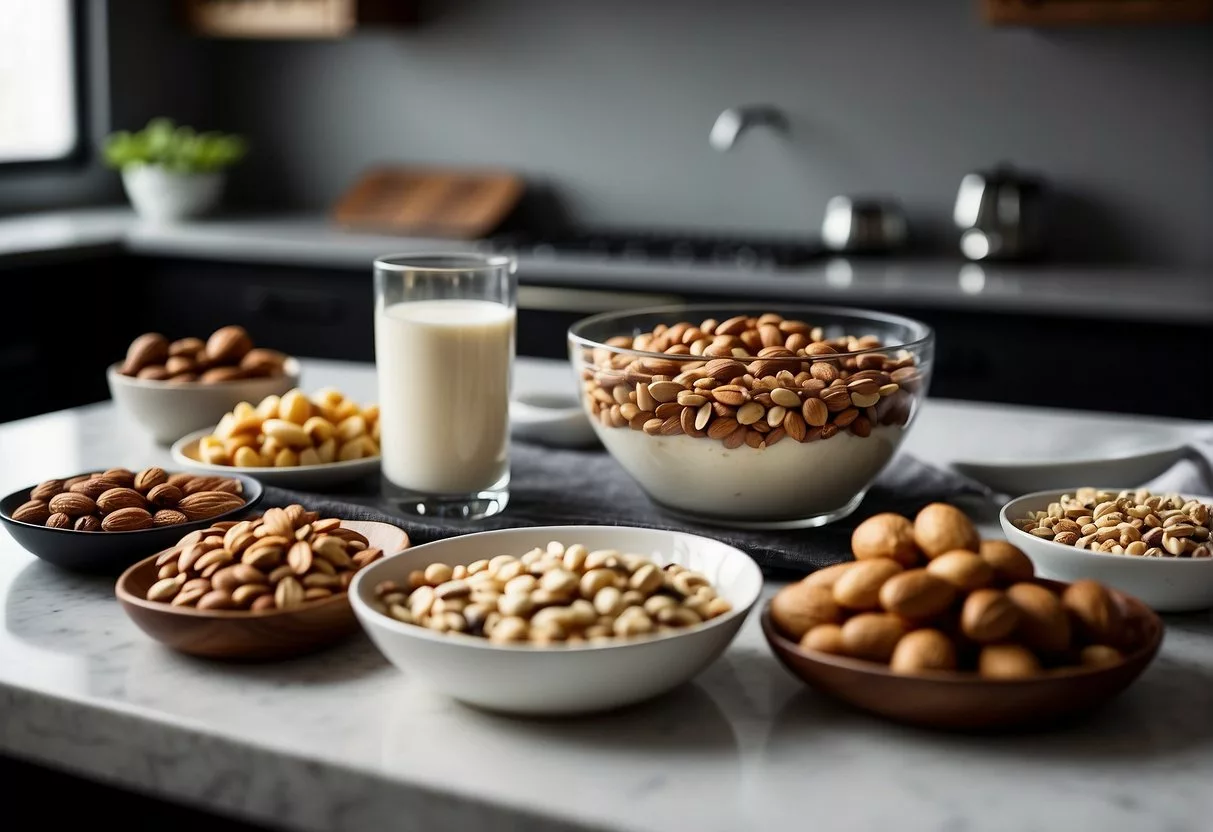
Smoothies
One can easily boost their protein intake with smoothies by adding ingredients like Greek yogurt or silken tofu, along with a mixture of fruits and a base such as almond milk.
Chia Pudding
Chia pudding is a versatile option; mixing chia seeds with almond milk and letting it sit overnight creates a pudding-like consistency.
Adding a handful of nuts like almonds or walnuts can increase the protein content.
Savory Dips
Hummus, made from protein-rich chickpeas, and yogurt dips, utilizing plain Greek yogurt, both serve as perfect pairings with vegetables or whole-grain toast for additional fiber.
Power Parfaits
Creating a parfait with layers of Greek yogurt, mixed nuts, and a drizzle of honey is not only delicious but also a powerful protein snack.
Turkey Roll-ups
Thinly sliced turkey breast can be rolled with lettuce and sliced tomato for easy-to-make, on-the-go turkey roll-ups.
Grains and Toasts
Quinoa and oats are grains high in protein that can be incorporated into snack bars or bowls.
Meanwhile, whole-grain toast topped with apple & peanut butter becomes a satisfying, protein-packed snack.
Nutty Trail Mix
Combining assorted nuts such as pistachios, cashews, and seeds yields a healthy and portable trail mix.
Seasoning with a touch of olive oil and lemon juice enhances the flavor without adding empty calories.
Seaside Snack
Finally, mixing tuna with a bit of olive oil and lemon juice, and serving it on a slice of whole-grain toast with sliced tomato, can create a delicious and protein-heavy light meal.
Shopping and Storage Tips for High-Protein Snacks
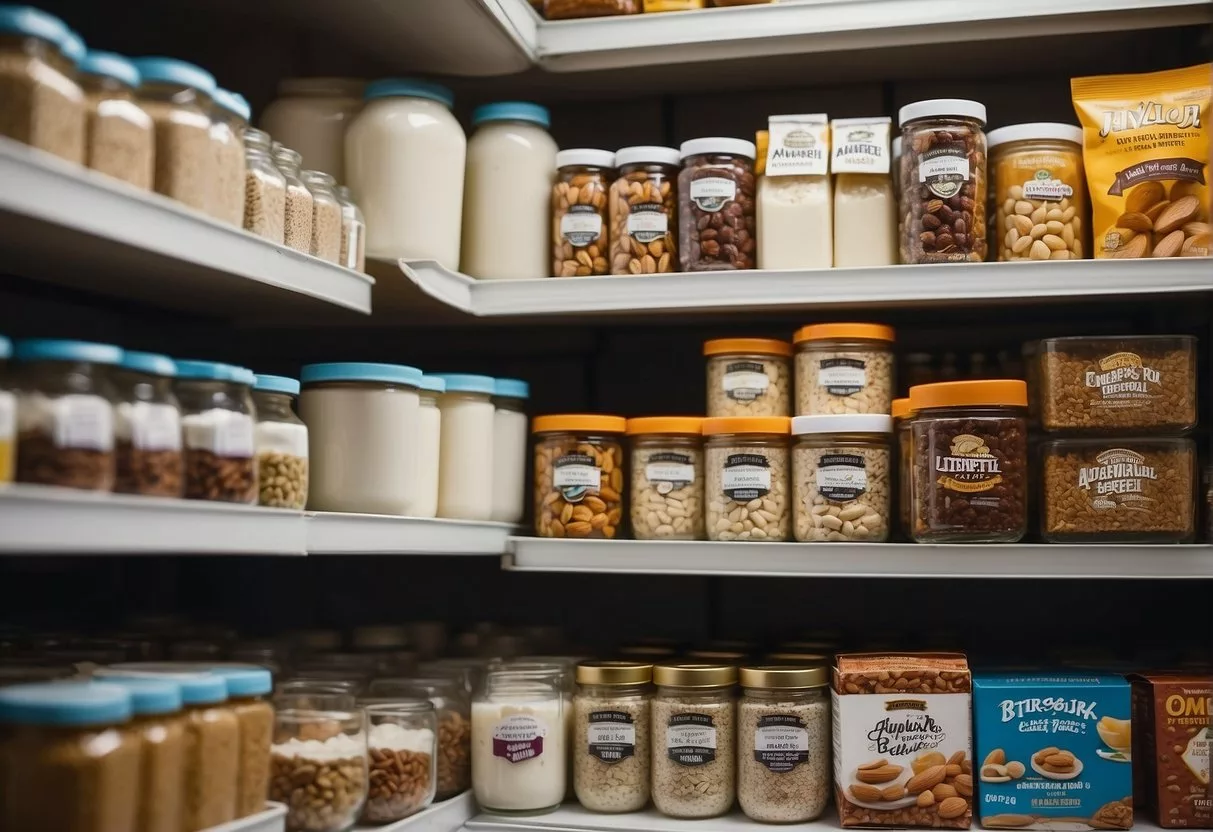
When selecting high-protein snacks at the grocery store, shoppers should look for items with minimal processing and added sugars.
A variety of nuts, seeds, and legumes, for example, can be bought in bulk and are excellent sources of protein that also offer healthy fats and fiber.
Storage is critical for maintaining the freshness and nutrient preservation of protein-rich snacks.
Nuts and seeds should be stored in airtight containers in a cool, dry place to prevent them from becoming rancid. For longer shelf life, they can also be kept in the refrigerator or freezer.
Here are some quick tips on storing common high-protein snacks:
- Jerky: Keep it sealed in a cool, dry place. Refrigerate after opening to prolong freshness.
- Cheese: Store in the refrigerator. If it’s a hard cheese, wrap in parchment paper then place in a plastic bag.
- Canned Fish: Store unopened cans in a cool, dry place. Once opened, transfer the fish to a sealed container and refrigerate.
For those involved in diet planning, considering the shelf life and storage needs of protein snacks is essential for reducing waste and ensuring a consistent supply of nutritious options.
Incorporating these snacks into a daily routine can support weight loss goals, as they help maintain satiety and reduce impulsive eating.
Proper preservation techniques also ensure that protein snacks retain their quality and nutritional value over time.
Dried meats and freeze-dried fruits are portable and long-lasting, making them suitable for on-the-go snacking without the need for refrigeration.
Balancing Macronutrients for Optimal Weight Loss
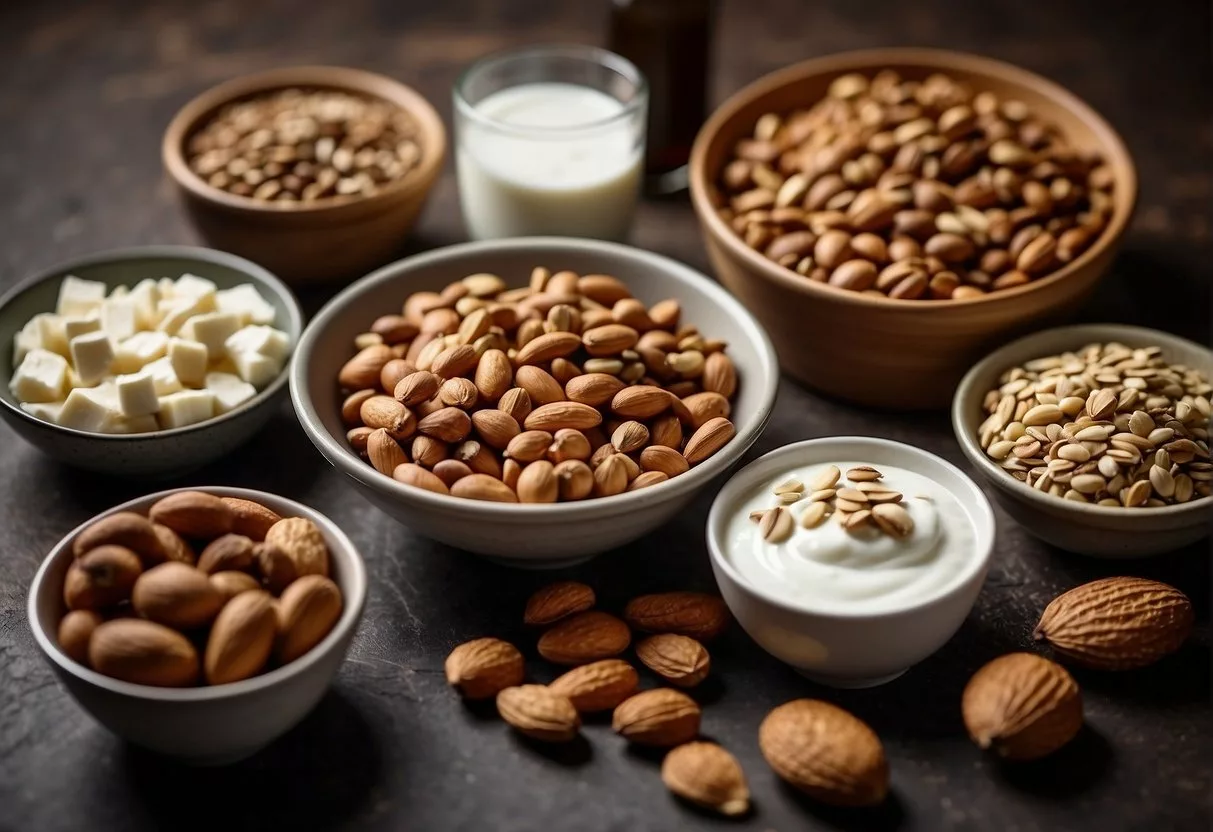
When targeting weight loss, understanding and managing macronutrients—carbohydrates, proteins, and fats—is crucial. They are the fundamental building blocks of a healthy diet and play distinct roles in body function and energy provision.
- Carbohydrates: Commonly represents 45-65% of total daily calories, providing fuel for daily activities and brain function.
- Proteins: Typically should account for 10-35% of total calorie intake, higher proportions can enhance satiety and support muscle preservation during weight loss.
- Fats: Necessary for hormone production and cellular health, should make up 20-35% of daily intake.
Effective meal planning involves a strategic balance of these macronutrients to promote fat loss while maintaining muscle mass.
Consuming protein-rich snacks can curb appetite, leading to reduced calorie intake overall.
Examples include Greek yogurt, cottage cheese, or cucumber sandwiches with deli turkey and cheese.
To illustrate, a sample snack breakdown might look like:
| Snack Item | Carbohydrates | Protein | Fat |
|---|---|---|---|
| Greek Yogurt | 5g | 10g | 0.7g |
| Cottage Cheese | 6g | 28g | 10g |
| Turkey Cucumber Sammie | 4g | 23g | 9g |
| *Values are approximate and can vary based on portion size and brand. |
Incorporating Snacks into a Healthy Weight Loss Diet
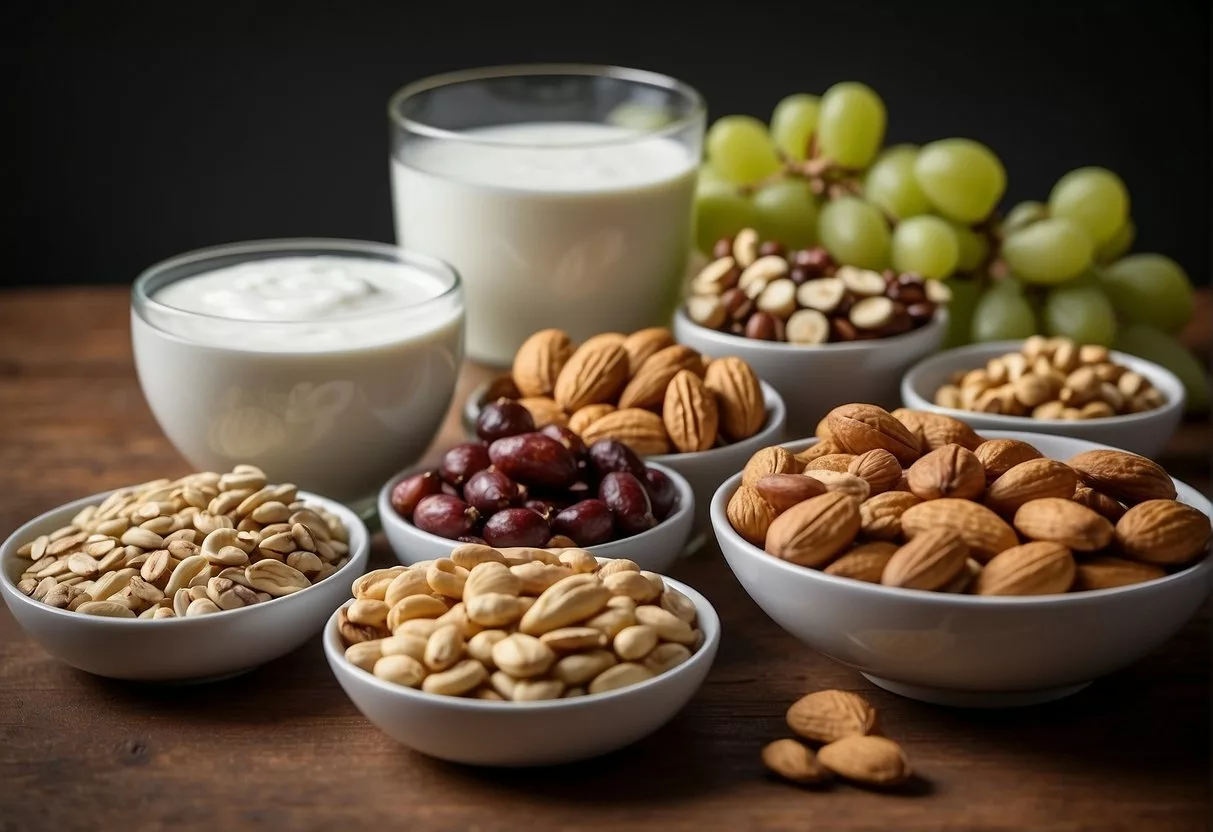
When it comes to weight loss, crafting a balanced diet that includes snacks can be a strategic way to manage hunger and control portions at meals. Snacks with high-protein content are particularly effective because protein supports satiety. This helps individuals to feel fuller for longer, which may reduce the likelihood of overeating during lunch and dinner.
Integrating high-protein snacks into one’s meal planning is essential for maintaining a healthy diet. A well-timed snack can bridge the gap between breakfast and lunch or lunch and dinner, preventing drops in blood sugar that can lead to overeating.
Here are some examples of high-protein snacks that fit into a weight loss diet:
- Celery sticks with peanut butter contain a good amount of protein, making it an easy and tasty option.
- A piece of whole grain toast topped with smoked salmon and a thin layer of cream cheese can provide a healthy balance of protein and healthy fats.
- Hard-boiled eggs are portable and can be prepared ahead of time for convenience.
- Cottage cheese with a handful of nuts or some slices of fruit can serve as a refreshing and filling snack.
In order to effectively make snacking an asset in one’s weight loss journey, include protein-rich options that align with body weight goals and overall nutritional needs. Always consider portion sizes, and opt for wholesome, unprocessed ingredients to maximize benefits.
Avoiding Common Mistakes with High-Protein Snacks

When choosing high-protein snacks for weight loss, individuals often make several common mistakes. Awareness of these pitfalls can help in maintaining a nutritious, low-calorie diet that supports weight management.
1. Overlooking Added Sugars:
Even snacks that boast high protein content may contain high levels of added sugar. For example, some protein bars masked as healthy options could undermine weight loss efforts. Checking the nutrition label is essential to avoid excessive sugar intake.
- Examples to Avoid:
- Flavored yogurt with added sugar
- Protein bars with chocolate coating
2. Misjudging Calorie Density:
It’s easy to overconsume calories with seemingly healthy snacks. Certain high-protein foods can be calorie-dense, making portion control critical.
- Low-Calorie, High-Protein Choices:
- Greek yogurt (plain)
- Cottage cheese
3. Choosing Less Nutritious Accompaniments:
Pairing protein with less nutritious options can offset the benefits. For instance, choosing white bread over whole grain options reduces the overall nutrient value.
- Better Choices:
- Whole grains such as quinoa or barley
- Whole grain bread instead of white or processed varieties
4. Ignoring Nutrient-Rich Whole Foods:
While processed snacks are convenient, whole foods often provide more nutrients and fewer additives.
- Nutrient-Packed Options:
- Fresh fruits and vegetables
- Unsalted nuts and seeds
5. Not Watching Portion Sizes with Dried Fruits and Nuts:
Dried fruit and nuts are nutritious but can be high in calories. They should be consumed in moderation as part of a balanced diet.
- Portion Control Tips:
- Measure out servings rather than eating from the bag
- Opt for dried fruit without added sugar
The Role of Snacking in Sustaining Weight Loss
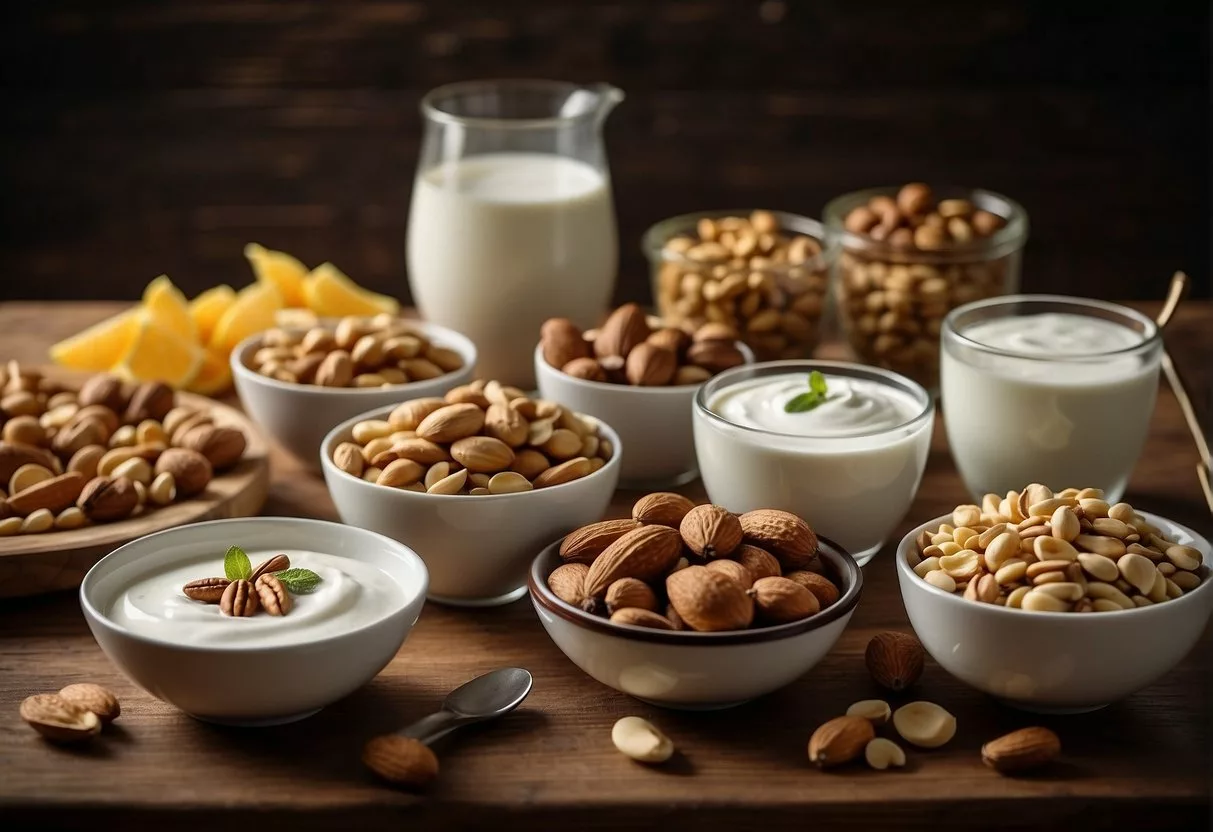
When considering weight loss, it is integral to focus not just on regular meals but also on the strategy of snacking. Strategic snacking plays a crucial role in sustaining weight loss by managing hunger and providing steady energy levels.
Meal planning is essential, and incorporating healthy, high-protein snacks can contribute significantly to satiety. Protein is more satiating than carbohydrates or fats, meaning it can help individuals to feel full longer. This reduces the likelihood of overeating during main meals.
Nutritious snacks also play a part in healthy digestion. Options such as yogurt or mixed nuts provide probiotics and fiber which aid in digestion and help maintain gut health. A well-functioning digestive system can be beneficial in weight management.
Here’s why snacking can effectively support weight loss:
- Protein-rich snacks contribute to a feeling of fullness, decreasing overall calorie intake.
- Regular, healthy snacks can prevent significant drops in blood sugar, curtailing the urge to overeat.
Maintaining a routine with balanced snacks can help regulate metabolic pathways and ensure the body has the fuel it requires without excess calories that lead to weight gain.
Examples of snacks that can be part of a weight loss plan include:
- Greek yogurt
- Cottage cheese
- A handful of nuts such as almonds or walnuts, known to aid in weight loss due to their nutritional and health benefits.
- Slices of turkey or chicken breast
Understanding the Impact of Proteins on Body and Bone Health
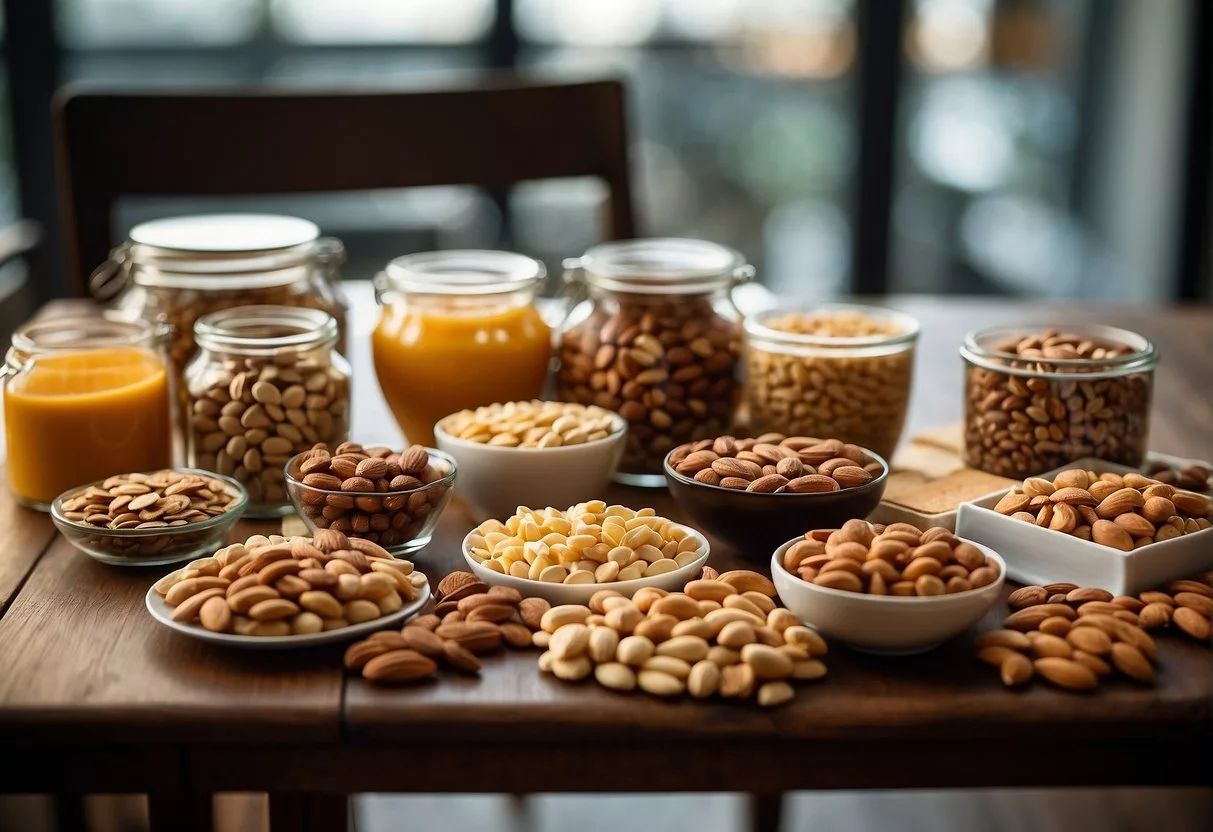
Proteins are essential macronutrients that play a crucial role in the maintenance and repair of tissues in the body, including muscles and bones. They are made up of amino acids, which are the building blocks for many structures within the body.
Body Weight: High-protein snacks can be beneficial for weight loss because proteins increase satiety, meaning they help individuals feel full for longer periods. This can lead to reduced calorie intake throughout the day. In weight management programs, a controlled intake of proteins can assist in the preservation of lean muscle mass while promoting fat loss.
Bone Health: Proteins contribute to bone health by supporting the structure and strength of bones. Adequate protein intake is linked with increased bone mineral density (BMD), which reduces the risk of fractures and osteoporosis. Proteins work alongside other nutrients, such as calcium and vitamin D, to optimize bone health. Research indicates a variance in protein intake as individuals age, affecting bone density accordingly.
Heart Health: While not the primary focus in relation to bone health, proteins do play a part in maintaining heart health. The type of protein consumed—plant-based versus animal-based—can influence heart health differently due to the varying levels of saturated fat and cholesterol.
Incorporating high-protein snacks into a diet can be a strategic approach to support both body weight management and bone health. It is important that these snacks are part of a balanced diet that provides nutrients in proper proportions to ensure overall health and well-being.
Tracking Progress and Adjusting Snack Choices

When individuals embark on a weight loss journey, monitoring their progress is crucial. They can use various methods to track body weight. These methods include weekly weigh-ins, measuring body fat percentage, and keeping a food diary.
A consistent and accurate record allows for an objective view of their progression.
One should incorporate high-protein snacks into their meal planning strategically. These snacks can contribute to satiety and help maintain muscle mass while they lose fat. Here are some recommended protein-rich snacks:
- Greek Yogurt: An excellent source of protein and available in low-fat versions.
- Nuts and Seeds: Almonds, chia seeds, and pumpkin seeds provide quality protein and healthy fats.
It’s important to adapt consumption to energy needs. If a snack is higher in calories, one might need to ensure it fits within their daily calorie goal. It’s equally important that individuals not only focus on weight but also on how they feel and how their clothes fit.
Diet tracking apps assist in managing intake. They can also suggest when to switch up snack choices based on nutritional goals and preferences. They can flag if someone is repeatedly choosing a snack too high in calories or lacking in essential nutrients. This prompts an adjustment in their snack selection.
Frequently Asked Questions
The “Frequently Asked Questions” section navigates through the nuances of selecting high-protein snacks that contribute to weight loss. It offers clear and concise answers tailored for those aiming to enhance their diet efficacy.
What are some easy-to-prepare, high-protein snack recipes that aid in weight loss?
Boiled eggs and peanut butter celery sticks are simple yet nutritious options that provide a balancing act of proteins and healthy fats. This supports satiety and weight loss.
Can you list high-protein snacks that are under 100 calories and effective for shedding pounds?
Greek yogurt, cherry tomatoes coupled with mozzarella, and turkey roll-ups are excellent examples of snacks that are not only high in protein but also contain fewer than 100 calories. This makes them ideal for weight loss.
What store-bought snacks are high in protein and recommended for someone trying to lose weight?
For those seeking convenience, pistachios and roasted almonds offer a handy and protein-packed snacking option. They are also beneficial for weight reduction efforts due to their satiety-inducing properties.
What are the best snacks to eat at night for weight loss that are both satisfying and high in protein?
Cottage cheese with berries or a small serving of casein protein shake can be particularly effective as nighttime snacks. They are not only high in protein but also slow to digest, which can reduce late-night cravings and aid in muscle repair during sleep.
How can high-protein, low-carb snacks support rapid weight loss goals?
High-protein, low-carb snacks such as hard-boiled eggs or celery with almond butter assist in weight loss by contributing to muscle maintenance, promoting fullness, and limiting calorie intake without sacrificing nutrition.
Which snacks specifically target belly fat reduction while being high in protein?
No snack can target belly fat reduction exclusively. However, options like Greek yogurt or a protein smoothie with spinach can support overall weight loss. This, in turn, may lead to a reduction in abdominal fat.
They provide high-quality protein that assists in maintaining a healthy metabolism.